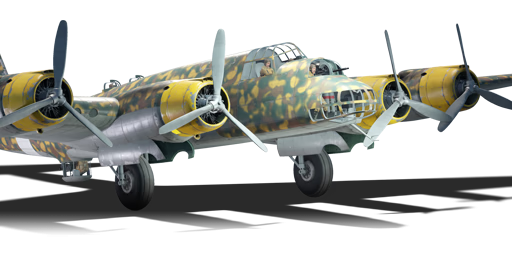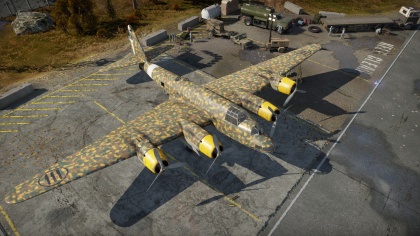P.108B serie 1
Contents
| This page is about the Italian bomber P.108B serie 1. For the attacker, see P.108A serie 2. For the other bomber variant, see P.108B serie 2. |
Description
The P.108B serie 1 is a rank III Italian bomber
with a battle rating of 3.7 (AB) and 3.3 (RB/SB). It was introduced in Update 1.69 "Regia Aeronautica".
The P.108B Serie 1 is a heavy bomber with a heavy bomb load and relatively weak defensive armament. When delivering the bombs to the targets, high altitudes are a must. The preferred targets of this bomber are stationary objects like pillboxes or slow moving vehicles such as ships (if you can time it well) and of course the bombing targets and airfields. Should an enemy fighter catch up with you, it is certain doom as your defensive guns have a low chance to kill it. To survive attacks, use your gunners to ward off the enemy aircraft until help comes. Stay away from combat as much as you can and do your job as a bomber.
General info
Flight performance
Describe how the aircraft behaves in the air. Speed, manoeuvrability, acceleration and allowable loads - these are the most important characteristics of the vehicle.
| Characteristics | |||||||
|---|---|---|---|---|---|---|---|
| Stock | |||||||
| Max Speed (km/h at 3,900 m) |
Max altitude (meters) |
Turn time (seconds) |
Rate of climb (meters/second) |
Take-off run (meters) | |||
| AB | RB | AB | RB | AB | RB | ||
| 401 | 388 | 9000 | 37.3 | 38.7 | 2.5 | 2.4 | 750 |
| Upgraded | |||||||
| Max Speed (km/h at 3,900 m) |
Max altitude (meters) |
Turn time (seconds) |
Rate of climb (meters/second) |
Take-off run (meters) | |||
| AB | RB | AB | RB | AB | RB | ||
| 438 | 419 | 9000 | 34.8 | 36.0 | 6.5 | 4.3 | 750 |
Details
| Features | ||||
|---|---|---|---|---|
| Combat flaps | Take-off flaps | Landing flaps | Air brakes | Arrestor gear |
| ✓ | ✓ | ✓ | X | X |
| Limits | ||||
|---|---|---|---|---|
| Wing-break speed (km/h) |
Gear limit (km/h) |
Combat flaps (km/h) |
Max Static G | |
| + | - | |||
| 515 | 290 | 400 | ~3 | ~2 |
| Optimal velocities | |||
|---|---|---|---|
| Ailerons (km/h) |
Rudder (km/h) |
Elevators (km/h) |
Radiator (km/h) |
| < 330 | < 310 | < 270 | > 250 |
| Compressor (RB/SB) | ||
|---|---|---|
| Setting 1 | ||
| Optimal altitude | 100% Engine power | WEP Engine power |
| 3,500 m | 1,350 hp | 1,499 hp |
Survivability and armour
- 8 mm Steel - Cockpit armour - instrument panel, pilot's seat, co-pilot's seat and floor plate below pilot
- 8 mm Steel - Armour plate protecting ammo located in wings
- 8 mm Steel - Side gunner armoured walls
- 8 mm Steel - Ventral gunner position
Armaments
Suspended armament
The P.108B serie 1 can be outfitted with the following ordnance:
- 34 x 50 kg GP 50 bombs (1,700 kg total)
- 34 x 100 kg GP 100 bombs (3,400 kg total)
- 2 x F200/450 torpedoes
- 3 x F200/450 torpedoes
- 7 x 250 kg GP 250 bombs (1,750 kg total)
- 7 x 500 kg GP 500 bombs (3,500 kg total)
Defensive armament
The P.108B serie 1 is defended by:
- 1 x 12.7 mm Breda-SAFAT machine gun, nose turret (300 rpg)
- 2 x 12.7 mm Breda-SAFAT machine guns, 2 x wing turrets (300 rpg = 600 total)
- 1 x 12.7 mm Breda-SAFAT machine gun, ventral turret (450 rpg)
- 1 x 7.7 mm Breda-SAFAT machine gun, 2 x beam turrets (400 rpg)
Usage in battles
Much like other heavy bombers in-game, one wants to unlock the heaviest loads ASAP and reach the strategic bomb point ASAP. The best defenses are the rear hemisphere, with wing turrets offering an exceptional area of coverage and solid firepower. With that in mind the best survival technique, if unable to climb above the enemy, is to fly close to the ground. Avoid letting enemies attack from directly below or in front. In RB matches with tank columns on the road, the 34 x 100 kg bomb load is effective at destroying armored columns, laying a dense line along the road the convoy is on will score kills and possibly win the match. Otherwise use the max load of 7 x 500 kg bombs for medium tanks and strategic targets. When using torpedoes, load all 3, skim the surface of water and make use of islands as you stealthy approach target. Spread the drop to increase chance of 1 torpedo hitting, unless point blank, then all can be rapidly dropped.
Manual Engine Control
| MEC elements | ||||||
|---|---|---|---|---|---|---|
| Mixer | Pitch | Radiator | Supercharger | Turbocharger | ||
| Oil | Water | Type | ||||
| Controllable | Controllable Auto control available |
Controllable Not auto controlled |
Controllable Not auto controlled |
Separate | Not controllable 1 gear |
Auto controlled |
Modules
| Tier | Flight performance | Survivability | Weaponry | ||
|---|---|---|---|---|---|
| I | Fuselage repair | Radiator | Turret 7 mm | MCSAP100 | |
| II | Compressor | Airframe | New 7 mm MGs (turret) | TBC-79 | |
| III | Wings repair | Engine | Turret 12 mm | MCGP250 | |
| IV | Engine injection | Cover | New 12 mm MGs (turret) | MCRO500 | |
Pros and cons
Pros:
- 2 turrets are placed on the distant engines allowing for more guns to face backward
- Heavy payload available
- One of two planes (the other being the P.108B serie 2) in the game that can carry three torpedoes
- Has a nose gun unlike the P.108B serie 2 which means it is better suited in head-on situations
Cons:
- Gunners are bunched together and easily knocked out
- Turrets on the engines cannot face forwards
- Poor manoeuvrability and climb rate
- Prone to fuel tank fire due to tremendous fuel load
- Massive size
- Relatively weak defensive firepower
History
Building large aircraft is difficult even for large companies, and it was no different when the famed Piaggio S.p.A. endeavoured to build a large bomber in the mid 1930s. Giovanni Casiraghi had recently returned after 9 years in America and was put in charge of building the original P.50-I mid wing design being made of wood and used the common-for-the-era tandem engine layout (e.g. Farman 222). This design was disappointing so Casiraghi reworked it into a more familiar 4 puller engine layout, but still made of wood. The P.50-II flew even worse, but the experiment was not a wasted exercise.
Casiraghi's next attempt was a major redesign, this time using aluminium as the primary structure material. Now a low wing design, it had a larger fuselage, more defensive turrets, and more powerful engines resulting in the P.108. Because he was working in the US at the time the B-17 first flew and was likely well informed of aviation advances, it is possible Casiraghi took some inspiration from the Flying Fortress, but for sure this was an original design. The finished design was very robust and could carry a heavy load over long distances, but its non-turbocharged engine did not offer the altitude or speed of the B-17. The P.108 was also one of the first aircraft to offer hydraulically powered remote control turrets, located in each of the outboard engines with gunners sitting mid fuselage, and a retractable hydraulic powered turret predating the famed B-17's ventral ball turret (not the same as "dust bin" type that lowered under the aircraft, but the weapon was moved by hand).
In 1941 the first P.108s were delivered to a single unit, the 274a Squadriglia (274th Squadron). Being far larger, heavier, and a little more troublesome than other Italian aircraft, a number of accidents ensued from inexperience with this beast of an aircraft. One casualty was the commander of the 274a Squadriglia, Bruno Mussolini, son of Benito Mussolini. Bruno was considered a skilled and serious pilot thus likely earned his position as commander, so the cause of the 7 August 1941 accident is speculative.
During the war P.108's performed a number of long range missions in the Mediterranean with no notable success. It was an effective bomber, but the numbers where never sufficient to impact the Allies. Loses mounted changing tactics and removing weight. By the time Italy surrendered only 9 of the approximately 24 built P.108B's remained. An interesting footnote, over a dozen of the transport version, P.108T, were also built, most of those were confiscated by the Germans and used to evacuate troops on the Eastern Front.
Media
Excellent additions to the article would be video guides, screenshots from the game, and photos.
See also
Links to the articles on the War Thunder Wiki that you think will be useful for the reader, for example:
- reference to the series of the aircraft;
- links to approximate analogues of other nations and research trees.
External links
Paste links to sources and external resources, such as:
- topic on the official game forum;
- encyclopedia page on the aircraft;
- other literature.
| Piaggio Aero | |
|---|---|
| Attackers | P.108A serie 2 |
| Bombers | P.108B serie 1 · P.108B serie 2 |
| Italy bombers | |
|---|---|
| Fiat | B.R.20DR · B.R.20M M1 |
| Savoia-Marchetti | S.81 · S.M.79 serie 1 · S.M.79 B · S.M.79 serie 8 · S.M.79 AS · S.M.79 bis/T.M |
| CANT | Z.1007 bis serie 3 · Z.1007 bis serie 5 |
| Piaggio | P.108B serie 1 · P.108B serie 2 |
| Foreign: | |
| Germany | ▄Ju 87 R-2 · ▄Ju 87 D-3 |
| Hungary | ◔Tu-2S-59 |





